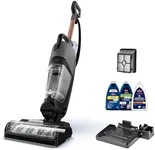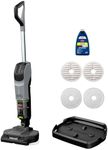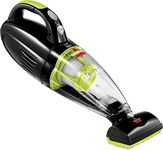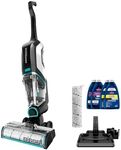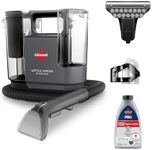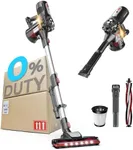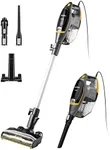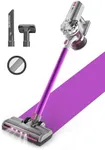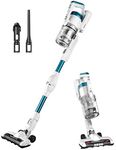Buying Guide for the Best Bissell Cordless Vacuums
Choosing the right cordless vacuum can make a significant difference in maintaining a clean home with ease. Cordless vacuums offer the convenience of mobility without the hassle of cords, making them ideal for quick clean-ups and reaching tight spaces. When selecting a cordless vacuum, it's important to consider several key specifications to ensure it meets your cleaning needs and preferences. Here are the key specs to look out for and how to navigate them.Battery LifeBattery life indicates how long the vacuum can operate on a single charge. This is crucial because it determines how much cleaning you can do before needing to recharge. Battery life can range from 15 minutes to over an hour. For small apartments or quick clean-ups, a shorter battery life may suffice. However, for larger homes or more extensive cleaning sessions, look for a vacuum with a longer battery life to avoid frequent interruptions.
Suction PowerSuction power measures the vacuum's ability to pick up dirt and debris. It's important because stronger suction ensures more effective cleaning, especially on carpets and rugs. Suction power is often measured in air watts (AW) or kilopascals (kPa). For homes with mostly hard floors, moderate suction power may be adequate. If you have carpets, pets, or high-traffic areas, opt for a vacuum with higher suction power to ensure thorough cleaning.
WeightThe weight of the vacuum affects how easy it is to maneuver and carry around. Lighter vacuums are easier to handle, especially for extended cleaning sessions or when cleaning multiple floors. Cordless vacuums typically weigh between 3 to 10 pounds. If you have limited strength or need to carry the vacuum up and down stairs, a lighter model would be more suitable. For those who prioritize powerful performance over ease of handling, a slightly heavier vacuum might be acceptable.
Dustbin CapacityDustbin capacity refers to the amount of dirt and debris the vacuum can hold before needing to be emptied. This is important for convenience and efficiency, as a larger dustbin means fewer trips to the trash can. Capacities can range from 0.3 liters to over 1 liter. For smaller living spaces or less frequent cleaning, a smaller dustbin may be sufficient. For larger homes or households with pets, a larger dustbin will reduce the frequency of emptying and make cleaning more efficient.
Filtration SystemThe filtration system captures dust, allergens, and other particles, ensuring cleaner air in your home. This is particularly important for those with allergies or asthma. Look for vacuums with HEPA filters, which can trap 99.97% of particles as small as 0.3 microns. If air quality is a top concern, prioritize models with advanced filtration systems. For general cleaning needs, a standard filter may be adequate.
Attachments and AccessoriesAttachments and accessories enhance the vacuum's versatility by allowing you to clean different surfaces and hard-to-reach areas. Common attachments include crevice tools, dusting brushes, and motorized pet tools. Consider what types of surfaces and areas you need to clean. If you have pets, look for models with specialized pet hair tools. For homes with a variety of surfaces, a vacuum with multiple attachments will provide more comprehensive cleaning options.
Charging TimeCharging time indicates how long it takes to fully recharge the vacuum's battery. This is important for planning your cleaning schedule and ensuring the vacuum is ready when you need it. Charging times can range from 2 to 5 hours. If you need to use the vacuum frequently or for extended periods, a shorter charging time is more convenient. For occasional use, a longer charging time may not be as critical.




